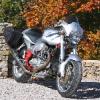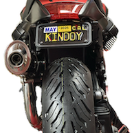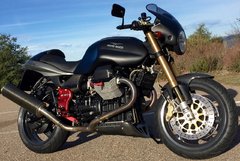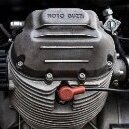Leaderboard
Popular Content
Showing content with the highest reputation on 06/12/2024 in all areas
-
4 points
-
Found my problem, my JBWeld didn't hold. It blew the cap back off. Fortunately, I have another angle drive from my NOS speedo, so I replaced it, and it too has been gobbed with JBWeld. It's on there thick, I expect it will hold, better than the other as this cap has never been removed. "Jesus, a little mercy please."3 points
-
It's really a matter of semantics. There is no difference beyond the frame of reference. 'intake vacuum' is mostly an automotive prase, and measured relative to atmospheric pressure, as cars rarely go to altitude enough to change the frame of reference. 'manifold pressure' is used in aviation, because aircraft obviously gain enough altitude that the atmospheric pressure changes so much you can't use differential between atmospheric and intake pressure meaningfully. 'manifold pressure' is an absolute measured above zero, 'intake vacuum' is a differential between above and below throttle plates. Additionally, many aircraft (and modern autos) have turbo/superchargers which boost pressure above 'vacuum' so the phrase isn't applicable. Glad I could make that clear lol3 points
-
Well not strictly true. One advantage of Diesel engines is they have no throttle body and therefore no throttle blades. The engine speed and ability to produce torque is controlled by varying the volume of fuel only. A piston aircraft engine with a variable pitch prop the power is controlled by adjusting the throttle to a specific manifold pressure and the engine rpm is controlled with the pitch lever. It's a bit like a helicopter driven by a gas turbine. In that case the engine turns 100% rpm all the time and when you pull up on the collective pitch it coarsens the blade angle of attack which provides the lift and this requires more power so it schedules more fuel to maintain the RPM at that load. RPM stays the same. Turbopro aircraft much the same. An NA petrol engine will produce a manifold vacuum at idle and part throttle, more vacuum at high rpm on the overrun with a closes throttle and a little less than atmospheric at WOT. Before takeoff in a piston engine a/c the pilot will do a 30inch check at the threshold run up bay to ensure he is making full power before the actual takeoff. @Chuck needs to chime in he's the expert in this area.3 points
-
I’m looking for an oem ballabio or cafe sport fairing in any condition. Let me know if you can help or point me in the right direction thx, dave2 points
-
I was never really interested in Portugal before flying out to Luanda from Lisbon. I never had the time to visit much of Lisbon, but I enjoyed Faro a lot. The water is cold, but it is very sunny, friendly, and if you like fish, you can treat yourself as much as you can eat. You will not break the bank.2 points
-
I looked at the previous version, but passed. This looks better. It reminds me of using roll-charts, which show each upcoming decision, but can't give you the full context. I can see where this would be really useful in single-point city navigation, which I don't do much of. I have a Cardo PacTalk for some of my helmets, which allows me to use voice commands to my phone and ask Siri for directions while I am riding. The ability to change destinations while riding seems like it would be a limitation of the BeeLine device. I'm using the speakers in the helmet, I can still make out the directions with earplugs if I have the volume up high enough.1 point
-
It occurred to me to point out there are two angle drive, the other being attached to the speedometer end. It is usually not the trouble that the gearbox one is, but is worth inspecting.1 point
-
Yeah a separate thread seems appropriate..I started one on the subject a couple of years ago but didn't seem to generate much interest at the time.1 point
-
Tinnitis has always been a fascinating topic to me- I've always had it, since my earliest memories. It doesn't bother me at all, in fact in a very quiet environment I find myself playing with it rather like a musical instrument. I can ignore it to the point of 'absence' or I can make it amazingly loud. I suspect these are artifacts of perception more than a physical condition. In no way does it ever affect my hearing. I struggle to imagine what it would be like without it, and also what it must be like to acquire it after a life without it; Lastly, if there isn't some way to replace the annoyance with accommodation such as I must have. Separate thread?1 point
-
Quality hearing aids help with tinitus, After many years of working for Wide World of Sports as a camerman on the starting line at top fuel drag races, etc, listening to loud music, racing dirt bikes, riding street bikes,as well as hours sailing in the wind on the open Ocean all without ear protection in my younger years ,I used to have tinitus it was driving me batty, I then sought out a good audiologist who mostly works with concert musicians and other professionals. After thorough testing the hearing aids I got some very good hearing aids and they kind of changed my life..I could listen to music in my car and be amazed to hear words and instruments in my favorite music I had never heard, not have to ask people what they said repeatedly, and feel a part of conversations at the dinner table where I had begun just to tune people out. But most of all I mostly forgot about the tinitus unless someone mentioned it..It helps bring all those little external sounds and frequencies that you forgot you could not hear back into your hearing so you don't think so much about the noise in your head ..well worth the money to me..now of course I NEVER ride, not even around the block without good hearing protection.1 point
-
1 point
-
Different strokes, and all that. I have the audio on my navigation device switched off all the time, in the car and on the bike. I absorb information much better visually than aurally, and having to try and figure out what the machine is telling me is far more distracting that a quick glance at the screen. Unfortunately, tinnitus is not only caused by exposure to loud noise. Mine is most likely to an extent due to noise exposure, but probably not entirely. As far as I know, it is not really understood what all the causes could be, but I believe stress could be a factor, as well as who knows what else. Fortunately I mostly don't notice mine unless I actively think about it, but when I do, it is really loud.1 point
-
I started writing an answer to that, and then realised that it is probably too late at night for me to formulate my thoughts coherently. Nevertheless, in the course of thinking about it I found this article: https://en.wikipedia.org/wiki/Manifold_vacuum and realised that I had a "turned around" view of what the throttle does. One tends to think that opening the throttle is "urging on" the motor. As the article points out, in fact opening the throttle is more like "releasing the beast". Closing the throttle is not "turning down the fuel", but rather "cutting off the air supply". Without the throttle, the motor (disregarding load) would run at maximun air intake and maxium revs all the time. Introducing the throttle into the equation provides the possibility to choke off the air supply, and keep the motor at idle, or lower than maximum revs. So "intake vacuum" is kind of an indication of how much the motor is being held back by the throttle, and "manifold pressure" is the actual air (or gas, or air/fuel mixture) pressure in the manifold at any given state of throttle opening. I think.1 point
-
May I frame the question this way: How is "manifold pressure" different than "intake vacuum?"1 point
-
I don't really need nav on the bikes but I often wondered if this would work. I spent a 42 year career in aviation and cared for my hearing immaculately after seeing a lot of the old guys I started working with deaf as posts. Always wore ear plugs on the bike and never went to loud music concerts or such things. Didn't stop me from getting Tinnitus though1 point
-
The only permanent fix: https://speedhut.com/categories/gauge-types/led-lighting/speedometers.html1 point
-
He's better than a nerd. He's also a commercial pilot with a captains rating for a major US airline, owns two performance car tuning and accessory companies and has written a few books on automotive turbocharging. He knows his stuff. Phil1 point
-
O.k. After 55 years of riding on and off road ,and as many years of listening to loud music..plus a number of years in my 20's covering Top fuel dragsters and funny Cars out on the Starting line as a cameraman for wide world of sports my hearing is getting pretty bad...I saw a Specialist at Stanford this week had an Audiologist test me ...verdict =high frequency hearing loss and Tinnitus. I'm leaving now to start the process of getting Hearing aids.. Do you wear them? What do you do with them when you ride? I usually wear the best ear plugs I can find online..but that is hit or miss. Care to chyme in with your experiences? I figure its something we should ALL learn as much as possible about I found this article which explain's some of what I have heard about in the past. http://www.hearingtestlabs.com/motorcycle.htm1 point
-
0 points
-
My Speedhut are at 31,380 miles, 7 1/2 years, and have outlasted all of my efforts to keep three Veglia speedos (and numerous angle drives) in the game . . .0 points










